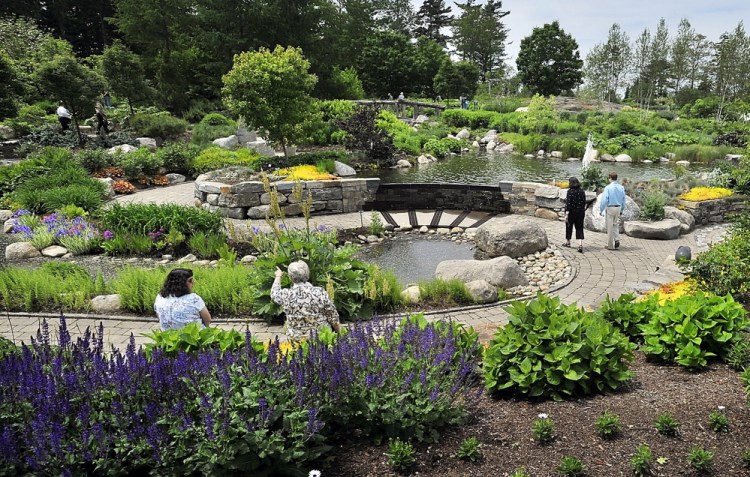This winter, Coastal Maine Botanical Gardens in Boothbay embarks on an expansion that encompasses a new parking lot and visitor center and eventually a conservatory. Five years hence, when garden visitors park, pay their entrance fees and stroll among the beautiful plants, they probably won’t be aware that much of the design that underpins the expansion is as green as the plants themselves.
Architects, engineers, builders and landscapers are incorporating features – both visible and invisible – designed to use water and energy as sparingly as possible.
WATER EFFICIENCY
It takes a lot of water to run a botanical garden, so water conservation is paramount, of course, especially after a dry summer like the one we just had.
In a forest, 90 to 95 percent of the rainfall soaks into the ground, replenishing aquifers and hydrating plants. Its planners want Coastal Maine Botanical Gardens to be as efficient as a forest.
To accomplish that, water conservation will be built into the new visitor center and parking lot.
The visitor center, for instance, will have a 150,000-gallon cistern collecting rainwater from the roof. That water can’t be used for drinking, but it can be used to wash dishes at the garden’s restaurant, to flush toilets and to irrigate.
For its part, the parking lot will be built with an unusual permeable-paving system.
With traditional paving, the water runs off into retention ponds and from there into septic systems; such systems require a lot of land. To minimize the land required, the garden will employ a system in which asphalt will be put down in a grid so rainfall will flow through it and into septic systems right under the parking lot.
The septic systems remove pollutants, and from there, the cleansed water goes into the aquifers that feed the garden’s wells.
Another upcoming project is construction of a bridge over wetlands and a half-acre pond, which will be able to contain 300,000 gallons of water. The bridge will lead into the new conservatory.
“That pond will be recharged with runoff from the conservatory and other hard surfaces and used for irrigation,” the garden’s Executive Director William Cullina said in a recent telephone interview about the expansion, “and, God forbid that we need it, fire suppression.”
CLEANER ENERGY
Energy efficiency is an equally important aspect of green design at Coastal Maine Botanical Gardens. The existing Bosarge Family Education Center, for instance, is a net-zero, LEED platinum building. An energy audit a few years ago found that it creates 40 percent more energy than it uses, Cullina said.
The new visitor center will be built to almost the same standards, with high-performance insulation; highly efficient heating, cooling and lighting; and a narrow footprint to take advantage of excellent natural light.
Unlike Bosarge, however, the new building will not have solar panels, as the site doesn’t lend itself to those, Cullina said.
He hopes to make up for that when Coastal Maine Botanical Gardens builds a farm and plant-propagation facility, also called for in the five-year plan.
More solar would be installed then, and possibly a system that tracks the sun as it goes across the sky, much as the flower heads of sunflowers and similar plants do. The solar panels in such systems are placed exactly perpendicular to the sun’s rays, so they get the full force of the sun, adding to the building’s energy efficiency.
The start of construction on a new conservatory is planned for mid- to late-2017. At first glance, the very idea of a big, glass-walled conservatory in wintry Maine seems to go against the concept of energy efficiency and green design. But Cullina said every effort is being made to reduce its energy use.
Unlike many conservatories, it will not recreate a tropical rain forest; instead, the nighttime temperature will be allowed to drop to a comparatively chilly 45 degrees. The roof will be made with energy-efficient acrylic that prevents heat loss; a shade blanket system is planned that can be pulled across the roof to improve energy efficiency; and a high-tech ventilation system should obviate the need for air conditioning come summer.
PLANTS THAT CONTRIBUTE
I asked Cullina if the garden plants themselves can contribute to eco-conscious design. In reply, he outlined a research project still in its early stages that will evaluate and rank how much specific plants contribute to the ecosystem.
“What I like about it is that it strips away arguments about whether it is native or a cultivar but just tests the quality of food for birds and animals, the length of time it is available for pollinators, if it is a food source for butterflies and moths, and whether it is nitrogen fixing,” he said. “Those are the greatest things to have when you look at the sustainability of plants.”
One day, when people design eco-friendly buildings, they may be able to cultivate greener-designed gardens in tandem.
Tom Atwell is a freelance writer gardening in Cape Elizabeth. He can be contacted at 767-2297 or at: tomatwell@me.com.
Send questions/comments to the editors.



